He left grandmother
I wanted to wait for the official NASA report on the activity of Curiosity, but it seems that people really miss it, since someone already has flowers on the Martian prairies. And NASA drags on the story of new achievements, so let's start without them. Yes, there are Curiosity finds, and even such that can confuse experienced Mars explorers, not to mention enthusiasts.
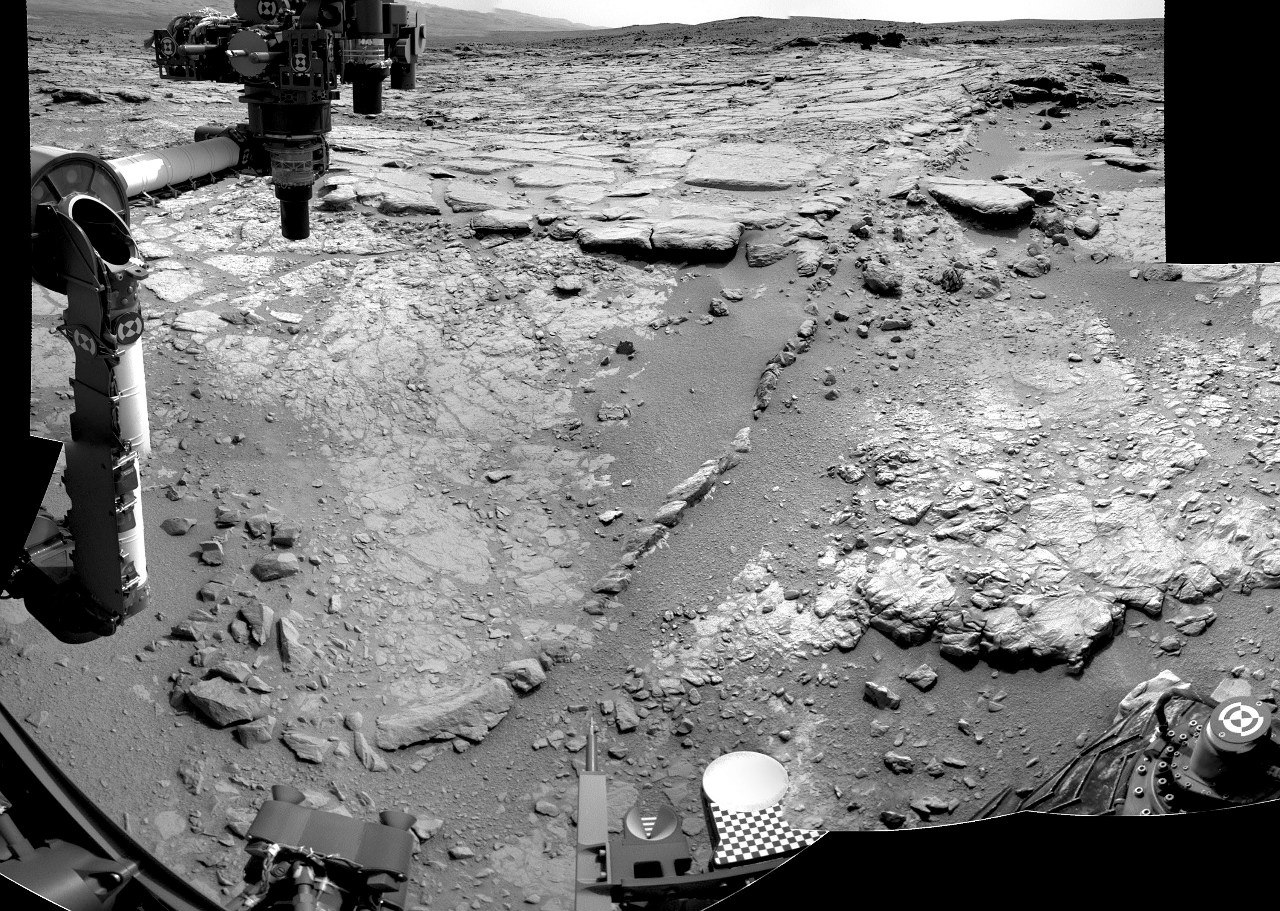
NASA does not know what an “emergency” is, therefore, regardless of the cost of working time of the rover, the Jet Propulsion Laboratory almost all went to the Christmas holidays. Before this, the operators drove Curiosity into a place from which it is good to survey the surrounding slopes. They called the place of the rover's vacation Grandma's House - the grandmother's house, where, in their opinion, it is best to celebrate Christmas. To ensure that Curiosity did not completely mess around, they prepared a multi-day work program for him. Usually they ask him a program for the day, but this time they planned activities a week in advance. This technique will come in handy in April, when the Sun appears between Mars and the Earth and the connection is interrupted for several days.
During the holidays, the rover took a full 360-degree panorama with the left 34-mm mast camera, and took a large panorama of the nearby outcrops with the right 100-mm mast camera.

Full size in gigapan
It was important not only to take photos, but also to forward them, because weak communications lead to the fact that the rover stores some frames received a month ago, or even more. During the holidays, we managed to transfer all the new pictures and put them in the guts.
For example, this “Misty Mountain” has practically no scientific value, so for more than a month there were more important things that needed to be shipped.

This is a shot for 100 sols (Martian day), when a dust storm approached Curiosity from the south. A few days later it became clear, but still now - on the 148th sol - visibility has not returned to the previous one.
Panoramas have opened many sites that can cause interest not only boring geologists, but also the surprise of outside viewers.
However, the fun began even earlier. I already said that in the Yellowknife Bay lowland, the rover discovered a new white mineral that filled the cracks in the main, dark rock.

( false color )
At the same time, the rover examined the stone, which journalists would later call the "Martian flower."
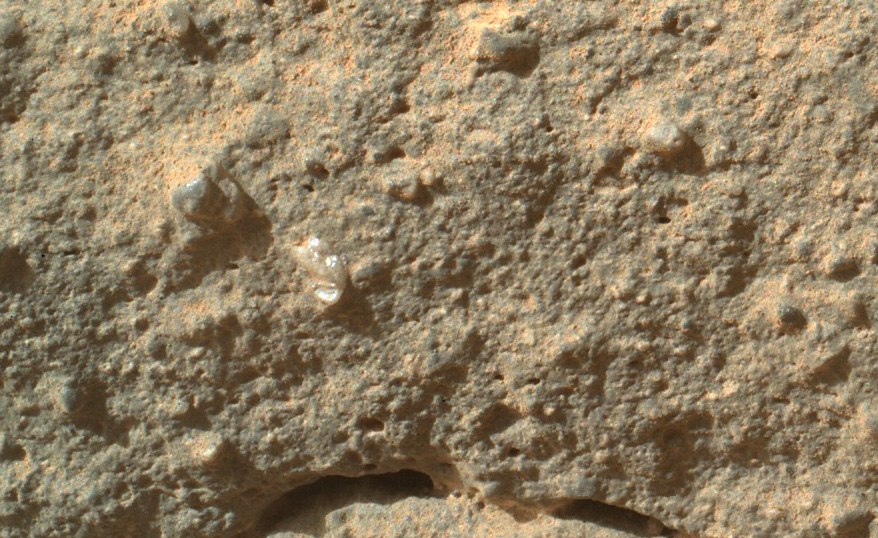
This is most likely quartz or some kind of related silicon compound that has no sensationalism. And how she got into the headlines, I'll tell you later.
After the rover examined the "flower", he moved to his grandmother's house for the holidays. It was then that the find was made, from which, for a minute, my eyes climbed over my forehead.
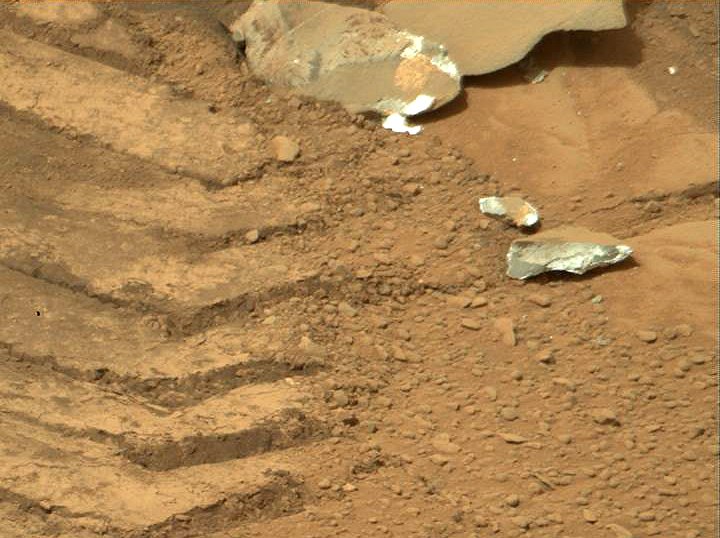
It is somehow difficult to believe that in this realm of red stones and brown sands, something so piercing white can be preserved. It is also not clear here whether this stone is so fragile, or whether it is a rover so heavy. The fact that it is really heavy can be guessed from this amazing shot:
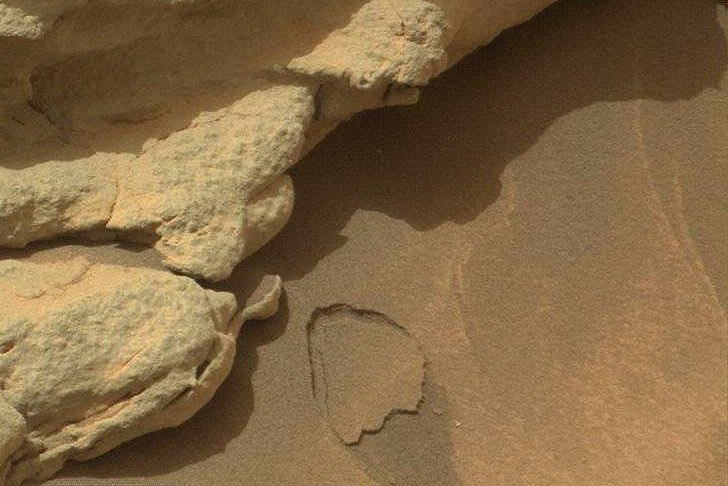
The Curiosity movement caused such a funny micro-landslide a couple of meters from the robot. But, apparently, these stones are fragile. In one shot, you can trace all the way through new white cracks.

What kind of mineral NASA has not yet told, however, the low interest in these findings from the rover suggests that there will be no sensation.

They shot a little laser at him, but did not even consider using the camera on the manipulator. Although the stones do not run away from them and are still at hand, they may also be busy.
But Grandma's House found a more interesting object.
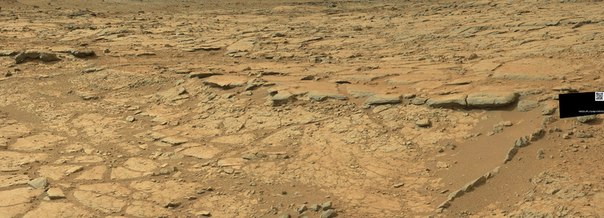
Larger sizes
An unusual ridge of stones visible on the right side of the panorama is called Snake River. I became interested in it for a long time, as soon as she appeared on the frames of navigation cameras. The stones lined up in a strange line obviously under the influence of some processes. Two options can be assumed immediately - this is moraine or filling a crack.
Morena is a chain of stones that, like a bulldozer, is collected by a glacier during movement. Moraines alone are not new to Mars.

But so far, no direct evidence of glacier activity on either kilometer or meter scale has been found in Gale Crater.
The second possibility of the appearance of such a linear structure is the filling of a crack. That is, there was a certain breed (although ice may be) that cracked, these stones attacked the crack. Then the whole base was destroyed (melted, weathered, was blurred), and the stones that fell into the crack were stronger and remained in place. The strangeness here is that such processes should cover all neighborhoods, and so far only one “snake” has been found.
What NASA decides about this, we will probably find out soon. The research process has just begun.
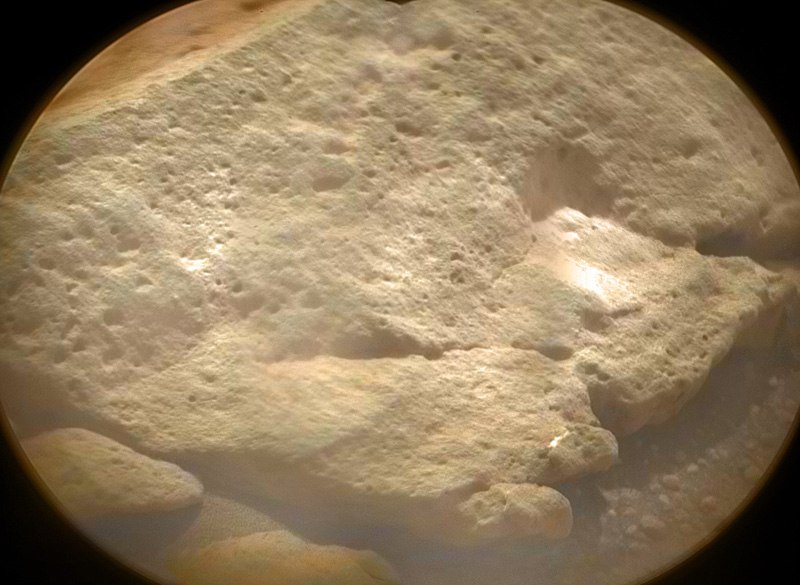
Without Snake River there is something to see and how to tickle the imagination. For example, if I had found such a stone in a quarry near Moscow, I would not have doubted for a second that it was a fossil.
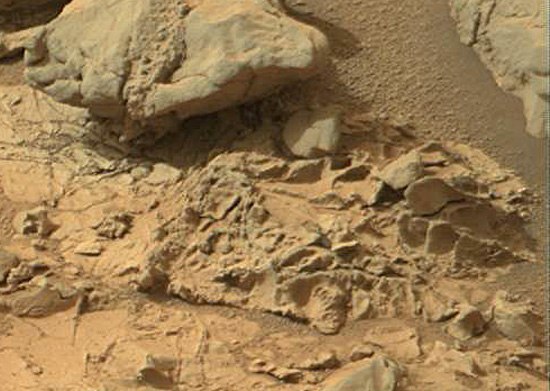
And already at the sight of these “branches” it is much more appropriate to talk about flowers and other green spaces.
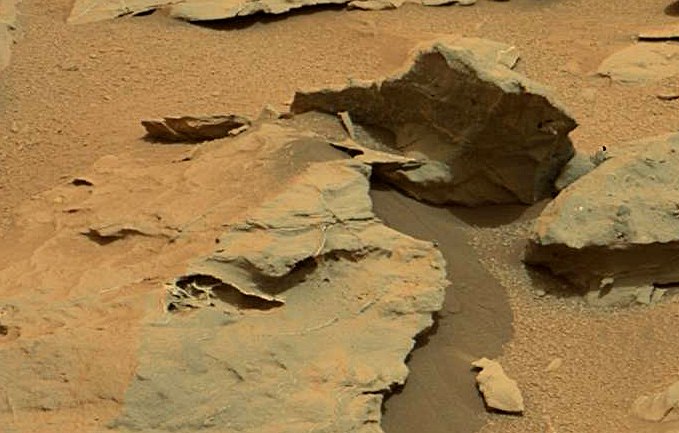
But here, everything is much simpler: cracked rock => filling cracks with white mineral => weathering of the main rock and stronger bonds of white.
The white mineral in the cracks is most likely gypsum. They have not yet talked about him, but there is every reason to believe that this is he himself. But the bright white content of fragile stones may be different. Recalling the activities of the "neighbor" Curiosity - Spirit, whose anniversary was recently celebrated, we can compare his find:
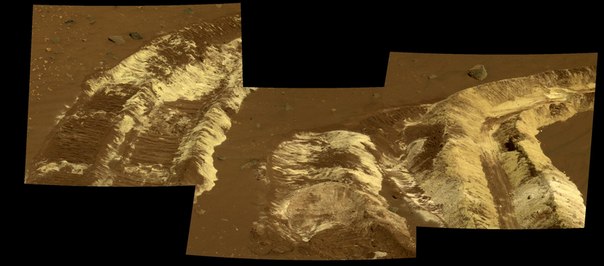
In his case, it turned out to be placers of sulfate salts. And in another place, such a find turned out to be quartz sand - an ideal raw material for the production of glass. In the Gusev crater, where Spirit worked, these placers arose during hydrothermal activity, but no geysers were supposed in the Gale Crater. The situation will become a little clearer when spectrographic analyzes are known, so we can only wait and not read Soviet newspapers at dinner.
Now about the "Martian flower" and the newspaper. His example shows how generally our sensational media, which are sensational.
Since December 3, when the previous saga " what did he find there"NASA did not tell scientific news from Gale Crater. Media editors understand that people are hungry for Mars, but there is no news from Mars. Then the most ingenious journalist goes to the ufological forum, selects the most absurd comment" Flower? ", And writes" the find stirred up a discussion forum "(Despite the fact that the majority of the forum recognized that it was an ordinary stone like quartz). Then the editor writes a little gag" perhaps a bright object fell off the rover, "adds a specialist comment:" This is a piece of rock "and it's done. I publish the article. t, and then other media begin to retype and translate it: they remove links to the ufological forum, comments of a specialist, and all that remains is " The rover photographed a flower on Mars ."

NASA does not know what an “emergency” is, therefore, regardless of the cost of working time of the rover, the Jet Propulsion Laboratory almost all went to the Christmas holidays. Before this, the operators drove Curiosity into a place from which it is good to survey the surrounding slopes. They called the place of the rover's vacation Grandma's House - the grandmother's house, where, in their opinion, it is best to celebrate Christmas. To ensure that Curiosity did not completely mess around, they prepared a multi-day work program for him. Usually they ask him a program for the day, but this time they planned activities a week in advance. This technique will come in handy in April, when the Sun appears between Mars and the Earth and the connection is interrupted for several days.
During the holidays, the rover took a full 360-degree panorama with the left 34-mm mast camera, and took a large panorama of the nearby outcrops with the right 100-mm mast camera.

Full size in gigapan
It was important not only to take photos, but also to forward them, because weak communications lead to the fact that the rover stores some frames received a month ago, or even more. During the holidays, we managed to transfer all the new pictures and put them in the guts.
For example, this “Misty Mountain” has practically no scientific value, so for more than a month there were more important things that needed to be shipped.

This is a shot for 100 sols (Martian day), when a dust storm approached Curiosity from the south. A few days later it became clear, but still now - on the 148th sol - visibility has not returned to the previous one.
Panoramas have opened many sites that can cause interest not only boring geologists, but also the surprise of outside viewers.
However, the fun began even earlier. I already said that in the Yellowknife Bay lowland, the rover discovered a new white mineral that filled the cracks in the main, dark rock.

( false color )
At the same time, the rover examined the stone, which journalists would later call the "Martian flower."

This is most likely quartz or some kind of related silicon compound that has no sensationalism. And how she got into the headlines, I'll tell you later.
After the rover examined the "flower", he moved to his grandmother's house for the holidays. It was then that the find was made, from which, for a minute, my eyes climbed over my forehead.

It is somehow difficult to believe that in this realm of red stones and brown sands, something so piercing white can be preserved. It is also not clear here whether this stone is so fragile, or whether it is a rover so heavy. The fact that it is really heavy can be guessed from this amazing shot:

The Curiosity movement caused such a funny micro-landslide a couple of meters from the robot. But, apparently, these stones are fragile. In one shot, you can trace all the way through new white cracks.

What kind of mineral NASA has not yet told, however, the low interest in these findings from the rover suggests that there will be no sensation.

They shot a little laser at him, but did not even consider using the camera on the manipulator. Although the stones do not run away from them and are still at hand, they may also be busy.
But Grandma's House found a more interesting object.

Larger sizes
An unusual ridge of stones visible on the right side of the panorama is called Snake River. I became interested in it for a long time, as soon as she appeared on the frames of navigation cameras. The stones lined up in a strange line obviously under the influence of some processes. Two options can be assumed immediately - this is moraine or filling a crack.
Morena is a chain of stones that, like a bulldozer, is collected by a glacier during movement. Moraines alone are not new to Mars.

But so far, no direct evidence of glacier activity on either kilometer or meter scale has been found in Gale Crater.
The second possibility of the appearance of such a linear structure is the filling of a crack. That is, there was a certain breed (although ice may be) that cracked, these stones attacked the crack. Then the whole base was destroyed (melted, weathered, was blurred), and the stones that fell into the crack were stronger and remained in place. The strangeness here is that such processes should cover all neighborhoods, and so far only one “snake” has been found.
What NASA decides about this, we will probably find out soon. The research process has just begun.

Without Snake River there is something to see and how to tickle the imagination. For example, if I had found such a stone in a quarry near Moscow, I would not have doubted for a second that it was a fossil.

And already at the sight of these “branches” it is much more appropriate to talk about flowers and other green spaces.

But here, everything is much simpler: cracked rock => filling cracks with white mineral => weathering of the main rock and stronger bonds of white.
The white mineral in the cracks is most likely gypsum. They have not yet talked about him, but there is every reason to believe that this is he himself. But the bright white content of fragile stones may be different. Recalling the activities of the "neighbor" Curiosity - Spirit, whose anniversary was recently celebrated, we can compare his find:

In his case, it turned out to be placers of sulfate salts. And in another place, such a find turned out to be quartz sand - an ideal raw material for the production of glass. In the Gusev crater, where Spirit worked, these placers arose during hydrothermal activity, but no geysers were supposed in the Gale Crater. The situation will become a little clearer when spectrographic analyzes are known, so we can only wait and not read Soviet newspapers at dinner.
Now about the "Martian flower" and the newspaper. His example shows how generally our sensational media, which are sensational.
Since December 3, when the previous saga " what did he find there"NASA did not tell scientific news from Gale Crater. Media editors understand that people are hungry for Mars, but there is no news from Mars. Then the most ingenious journalist goes to the ufological forum, selects the most absurd comment" Flower? ", And writes" the find stirred up a discussion forum "(Despite the fact that the majority of the forum recognized that it was an ordinary stone like quartz). Then the editor writes a little gag" perhaps a bright object fell off the rover, "adds a specialist comment:" This is a piece of rock "and it's done. I publish the article. t, and then other media begin to retype and translate it: they remove links to the ufological forum, comments of a specialist, and all that remains is " The rover photographed a flower on Mars ."
